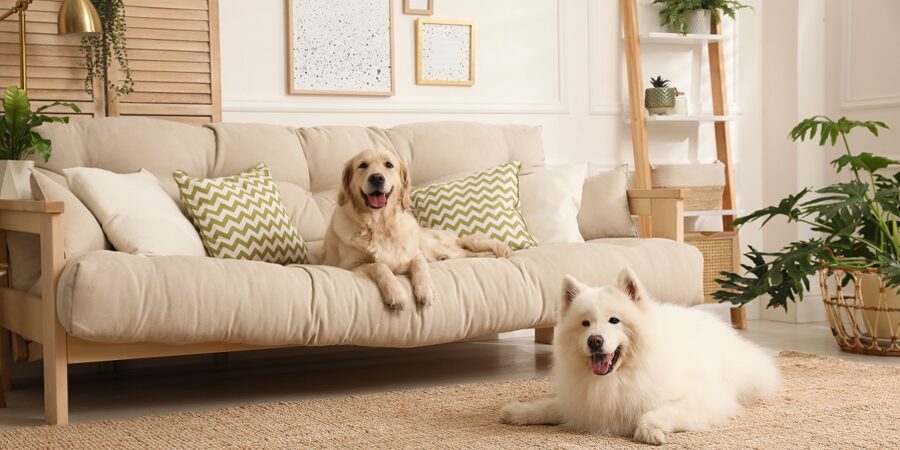
Multifamily
Pet Rules for Apartments: Policies to Attract & Retain Tenants
Written by: Parcel Pending
5 Min Read
Published: December 3, 2023
Updated: December 8, 2023
When it comes to creating a pet policy for an apartment community, property managers must remember that the largest groups of apartment residents in the country are increasingly also pet owners. This means that for many prospective residents, it’s critical that their furry friends are at home in the building where they live with their pet parents.
Apartment Pet Ownership: Facts & Figures
Did you know that there are currently more households with pets than with children? According to the most recent U.S. Census, the share of families with children living in their homes under the age of 18 has continued to decline. The share of homes with children in 2022 stands at 40%, down from 48% in 2002. Meanwhile, the American Pet Products Association states that 70% of American households own a pet (up from 56% in 1988).1 And recent studies have estimated apartment pet ownership landing somewhere in the range of 65-70% of U.S. households.2
It’s also worth noting the dominant force in the multifamily market: over 50% of Millennials rent, while Gen Zers are the only resident majority group, with 74% renting their homes.3 Together, these two groups of younger residents are also the most significant percentage of current pet owners at 33% for Millennials and 25% for Gen Xers, followed by baby boomers at 24%.4
It should come as no surprise, then, that many apartment residents consider their pet(s) the most important factor when making living decisions. Among prospective residents’ top considerations are proximity to pet services (e.g., veterinarians, pet groomers) and parks or other outdoor recreation spaces; walkability also made the list.5
Given these statistics, it is important to consider creating a pet policy when developing community rules and regulations, as well as the standard apartment lease agreement for your community.
Pet Rules to Consider for Your Apartment Community
Pet-friendly policies not only help retain existing residents but also appeal to new prospective residents and should be top of mind for property managers. Here are five essential property management tips to remember when establishing pet-friendly policies in your apartment community.6
Identify which pets are allowed
Pets come in all shapes, sizes, and temperaments. That is why property managers need to specify pet types, weight limits, and the maximum number of pets per unit for their communities as part of their pet policies.
Dog breeds are also an important consideration since local legislation and insurance policies may place restrictions on breeds that are considered dangerous or aggressive. Commonly restricted dog breeds include:
- Akita
- Alaskan Malamute
- Bulldog
- Cane Corso
- Chow Chow
- Doberman Pinscher
- German Shepherd
- Great Dane
- Mastiff
- American Pit Bull Terrier/American Staffordshire Terrier (i.e., Pit Bull)
- Rottweiler
- Siberian Husky
- Terrier
- Wolf hybrids
However, pet breed restrictions may be falling out of favor with residents. 77% of respondents to a 2022 NMHC/Grace Hill survey indicated that pet breed restrictions would either have no effect on their leasing decisions or would make them less likely to rent at a property with restrictions in place.7 Consider lifting breed restrictions from your community’s standard apartment lease agreement, but retaining the ability to deny any pet by evaluating them on a case-by-case basis if you are looking to be more pet-friendly and inclusive.
Make sure pets are clearly identified and vaccinated
For the safety of residents and other domestic animals in the building, it is essential that all pets be clearly identified with the appropriate collar tags and have the required licenses and vaccines. Each pet owner should ensure their furry friends are wearing tags to help get Fido or Kitty back to their owner if they go astray in or around the apartment premises.
Include a monthly pet fee
A monthly surcharge or security deposit is a good way for a pet owner to contribute to any additional maintenance costs associated with having pets in the community. It is important to remember that those with a service animal or an emotional support animal are exempt from pet policies that require paying fees, since these animals help their owners deal with a particular disability or condition.
Assign a dog relief area
Designating a green space for dogs to do their “business” is a real plus for pet owners living in an apartment community. If space allows, incorporate a dog park on the property so dogs can run leash-free in an enclosed area. It’s a pet-friendly amenity that will please pets and their parents.
Other Essential Elements of a Pet-Friendly Apartment Community
Simply allowing pets is no longer enough for today’s residents. Just as many people cannot live without certain conveniences, they have become just as concerned about the potential comfort levels of their pets. Here are a few basic amenities to consider implementing at your apartment community to make it more pet-friendly – and therefore more appealing to current and prospective pet parents.
Pet space and services
Basic services, such as a pet park with shade or well-stocked pet waste bag stations near trash receptacles, are key apartment amenities that can make your apartment community more comfortable for pets and their owners. Property managers can take innovative property management and a warm welcome a step further by partnering with local services (e.g., pet groomers, pet trainers, shelters, or adoption agencies) to offer services and events that benefit both current pet owners as well as residents that may be looking to add a new furry friend to the family.
Smart lockers for pet parents’ package deliveries
For busy, working pet parents ordering large bags of pet food and other pet accessories, Parcel Pending by Quadient smart lockers are a necessity. The electronic locker technology provides 24/7, secure, on-demand access to package pick-up for residents. Parcel lockers can help increase lease renewals by as much as 40%, save on staffing costs by automating the package management process, and are easily integrated into property management software or a custom application.
Ready to elevate your resident experience with an amenity that benefits residents and their furry friends? Speak to one of our package management experts today.
Sources:
- Lautz, Jessica. A Stunning Stat: There Are More American Households With Pets Than Children. www.nar.realtor. March 13, 2023. https://www.nar.realtor/blogs/economists-outlook/a-stunning-stat-there-are-more-american-households-with-pets-than-children
- Bradford, John. The State of Pets in Multifamily in 2023. www.multifamilyexecutive.com. February 5, 2023. https://www.multifamilyexecutive.com/property-management/apartment-trends/the-state-of-pets-in-multifamily-in-2023_o
- Rentcafe.com. US Rental Market Data. www.rentcafe.com. N.d.. https://www.rentcafe.com/blog/us-rental-market-data/ – renters-vs-owners-by-generation
- Megna, M. Pet Ownership Statistics 2023. www.forbes.com. June 21, 2023. https://www.forbes.com/advisor/pet-insurance/pet-ownership-statistics/
- Lautz, Jessica. A Stunning Stat: There Are More American Households With Pets Than Children. www.nar.realtor. March 13, 2023. https://www.nar.realtor/blogs/economists-outlook/a-stunning-stat-there-are-more-american-households-with-pets-than-children
- Kim, S. 5 Apartment Pet Policies to Implement at Your Building. www.butteflymx.com. N.d.. https://butterflymx.com/blog/apartment-pet-policies/
- National Multifamily Housing Council. The Future of Renting: Trends from the 2022 NMHC/Grace Hill Renter Preferences Survey Report. www.nmhc.org. January 18, 2022. https://www.nmhc.org/research-insight/research-report/nmhc-grace-hill-renter-preferences-survey-report/



